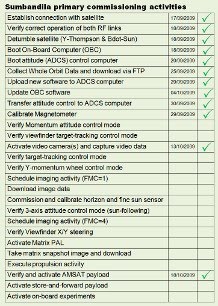We have made a further improvement to our ground station setup by replacing the existing UHF yagi antenna with one which has 4dB more gain. It is now mounted on the dish which eliminates some obstruction we experienced previously. During last night's passes we had a marked improvement in communications.
We have now downloaded almost 500kB of WOD, including fluxgate magnetometer readings which will enable us to calibrate the magnetometer. The ADCS system is continuing to perform well, as are the thermal and power subsystems.
There seems to be a high incidence of Single Event Effects (SEE) due to radiation, especially on the On-Board Computer (OBC). We have however designed all the electronics with latch-up protection, so none of the SEE occurrences to date have caused any permanent damage. Sometimes an SEE causes the OBC to reset and we have recently noticed that an auto restart of the processor then does not fully complete. With the WOD now available to us it seems that the lengthening of a timing constraint in software will be able to alleviate this problem. Note that we could not test for SEE on the ground so were not able to observe this timing effect prior to launch.


